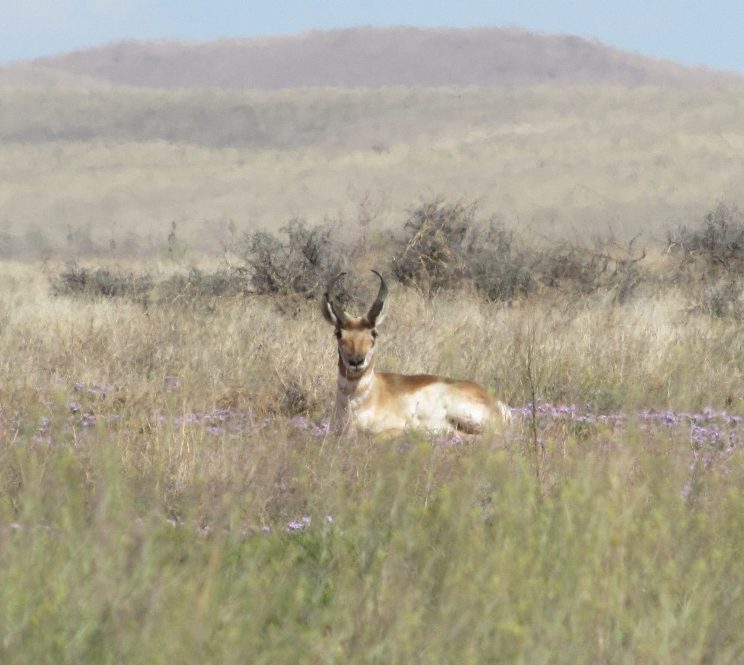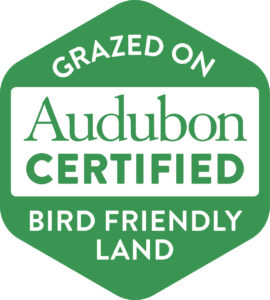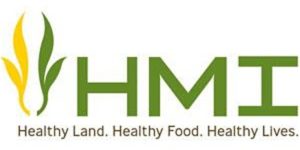A Summary of Wildlife Research on Dixon Water Foundation’s
Mimms Unit Demonstration Ranch,
Marfa, Texas 2008-2020
Introduction
Dixon Water Foundation’s (DWF) was founded in 1994 by the late Roger Dixon. The foundation’s mission is to promote healthy watersheds through good land management. The primary management tool used by Dixon Water Foundation is planned cattle grazing. Cattle are a management tool that is already on the landscape and can have impacts on a watershed scale. Dixon Water Foundation operates ranches in North Central Texas and in the Trans-Pecos region of Far West Texas. Our ranches are intended to be research and demonstration ranches that can be studied and open to those who want to see how various management techniques can impact the land.
Dixon Water Foundation purchased the 11,000 acre Mimms Unit ranch in Far West Texas in 2008. The Mimms Unit is located on the Northwest edge of the town of Marfa, Texas. In 2019, DWF purchased an adjacent 5,000 acre property, formerly the George Ranch, to bring the total acreage of the Mimms Unit to 16,000 acres. The Mimms Unit is named after Mr. and Mrs. William A. Mimms who settled on the property in 1904.
The Mimms Unit features three different grazing regimes and is arranged in a way to be able to study these different approaches to grazing. There are 19 1-acre fenced plots that are intended to exclude large animal grazing in order to see how the prairie may look under no cattle grazing. There is a large 2,139 acre single pasture that is continuously stocked with the same cow-calf herd. This is intended to represent a more traditional, unplanned approach to grazing. Lastly, there are about 9,330 acres that are internally fenced into smaller 30-acre pastures. A separate cow-calf herd is rotated through these pastures in a way that allows each pasture to be intensely grazed for a short period of time and rested for roughly a year. This approach supports a grazing approach that is often called rotational grazing, or adaptive multi-paddock grazing (AMP). With these different approaches implemented on the same ranch, researchers can study differences in plant and animal communities between them, analyze their findings, and determine if they find any different results across the different management approaches. This report details some of the wildlife research that has taken place on the Mimms Unit from 2008-2021.
Physical characteristics of the Mimms Unit
The Mimms Unit is predominantly a mixed-prairie ranch with elevation ranging from 4,724 feet to 4,944 feet. The ranch is mostly dominated by grama grasses such as blue grama, sideoats grama, sixweeks grama, and black grama. Other common grasses are sixweeks threeawn, feather windmillgrass, and nineawn pappusgrass. In addition to grasses, the Mimms Unit prairies host various forbs, or non-woody flowering plants that are not grasses, such as chocolate flower, silverleaf nightshade, david’s poinsettia, and shaggy dwarf morningglory. The ranch also contains occasional shrubs such as smooth sotol, soaptree yucca, and Torrey’s jointfir (ephedra). Brush and scrub species such as honey mesquite and creosote are scarce to rare on the ranch. (Carr 2019)

The Mimms Unit hosts a range of soils, with predominantly gravelly and sandy soils on much of the southwestern portion of the ranch, clay soils throughout the middle of the ranch extending from the northwestern corner to southeastern corner, and clay loam soils in the northeast. The Natural Resource Conservation Service describes these sites as not-prime farmland, but that it is suitable for conservative animal grazing.
The primary tributary running through the Mimms Unit is Alamito Creek, running from the Northwest to Southeast (Figure 2).
In 2011, the majority of the ranch burned during the Rockhouse Fire which spread from west of the town of Marfa, Texas, to the town of Fort Davis, Texas. (Figure 3).
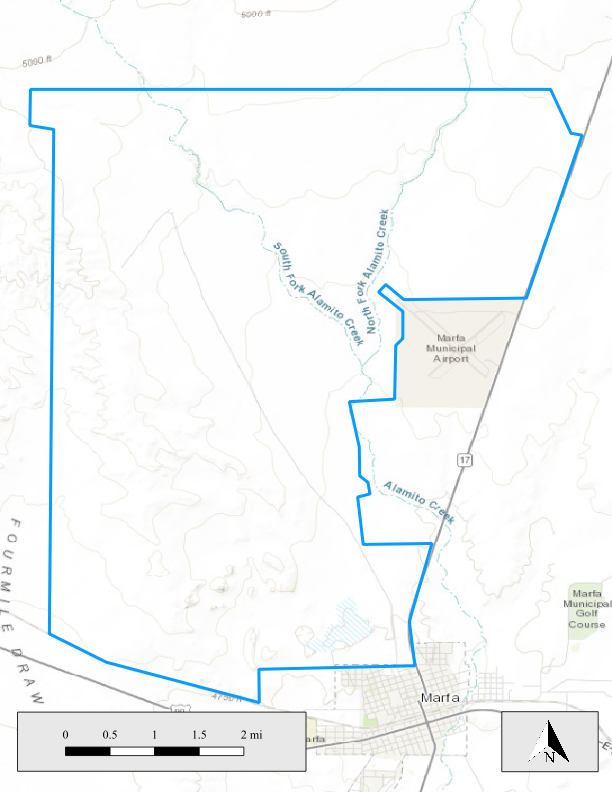

Wildlife on the Mimms Unit
Pronghorn
Pronghorn only exist in western North America. Previously, within the state of Texas, they ranged over 2/3s of the state (Figure 4). Now they can be found in two primary areas: the Texas Panhandle and the Trans-Pecos. The prairies of Mimms Unit are typical habitat for pronghorn. Pronghorn are the only member left of the animal family Antilocapridae, most of which are believed to have gone extinct in the Pleistocene. Pronghorn are known for their ability to sprint at great speeds, are referred to as antelope colloquially, and have long been an iconic resident of the American West. Texas Parks and Wildlife includes the Mimms Unit in regular surveys of the Marfa Plateau and include the Mimms Unit in annual surveys of their “core herd units”.
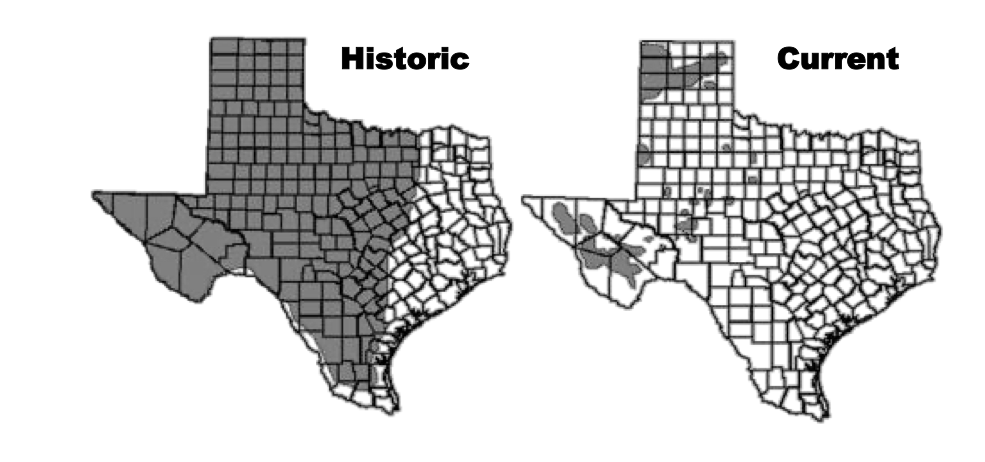
Recap of Pronghorn Research Findings
Survey results
After recording a historic low population number doing annual surveys in 2012 (2,752 pronghorn), Texas Parks and Wildlife Department (TPWD) implemented several research and restoration projects. These efforts included miles of fence modifications and also relocation of several hundred pronghorn from the Panhandle of Texas to the Trans-Pecos region. Populations reached 5,115 in 2019 and have remained steady.
Diet: Cattle and Pronghorn: (French, Locke)
A study conducted through the Borderlands Research Institute (BRI) at Sul Ross State University from April 2013-March 2014 (French 2015) explored pronghorn diet by analyzing fecal pellets in several study sites in the Trans-Pecos, Texas, including the Mimms Unit. Pellets were collected seasonally and analyzed using a process called fecal micro-histology. This study found that Trans-Pecos pronghorn consumed 84.9% forbs, 8.1% grasses, and 7.0% shrubs. While cattle also will eat forbs and browse on shrubs, their diet is comprised mostly of grasses (Taylor et al. 1980). This suggests that cattle and pronghorn are complimentary grazers.
Jacob Locke (BRI) researched biomass production, energy, and protein of forbs across the 3 grazing regimes on the Mimms Unit during 2018 and 2019. Vegetation samples were collected in September of each year, which is typically at the end of the warm and wet monsoon season and the peak time for plant growth. Locke’s research found that in 2018 the highest amounts of forb biomass production and nutritional content were in ungrazed portions of the ranch. In 2019 the rotationally grazed pastures produced the highest biomass of forbs and the most nutritional forbs. The continuously stocked pastures performed the lowest in both years. Average rainfall in the Trans-Pecos from 2011-2020 was 10.46” according to a weather station at the Marfa Municipal airport, directly adjacent to the Mimms Unit. Rainfall in 2018 fell mostly during the monsoon season and resulted in a total of 9”, while 2019 produced 10” of rain, spread throughout the season. Locke suggests that deferring grazing during years of below average warm season rainfall may be the best approach for promoting forbs for pronghorn, while rotationally grazing may produce better forbs during years of even and average rainfall. This research is continuing at BRI under a new student and will be looking at production in winter (January) and spring (May) to expand upon Locke’s dataset which was collected in September.
Parasites, Fawn Production and Survival, Mineral Levels (Weaver)
In 2010, various stakeholders in the Trans-Pecos voiced concern about declining pronghorn numbers. Student researcher James Weaver with BRI looked at parasite loads, mineral levels, and fawn survival in the Trans-Pecos and used the Mimms Unit as one of his study sites. Weaver found higher parasite loads, specifically the barber-pole or haemonchus worm, in Trans-Pecos pronghorn as compared to pronghorn from the Texas Panhandle, where their populations are much higher. Weaver also found that copper liver levels and selenium levels were different between pronghorn sampled in both regions. Additionally, fawn survival and production was much lower in the Trans-Pecos.
Weaver’s takeaway from this study suggested that grazing management can have a large role in impacting pronghorn populations. Fencing can play a crucial role in the health of pronghorn populations. Pronghorn are a grassland species adapted for open spaces. Though they have been seen jumping fences, they’re built for spotting predators at far distances and evading them with speed. When they reach a structure such as a fence, they may have trouble navigating it due these adaptations.
Legacy net-wire fencing from sheep and goat ranching in the Marfa-area proved to be a difficult barrier for the movement of these wide-ranging animals (Figure 6). Subsequent movement studies through BRI showed that pronghorn were often caught at fence lines and fence corners with collars that tracked location data logging dense concentrations of recordings at these sites. Weaver’s study suggested that higher parasite loads and mineral inconsistencies between the Panhandle and Trans-Pecos may have been due to the inability of pronghorn to access ideal range conditions due to these impediments to their movement. Likewise, pronghorn fawns require concealing groundcover to protect them from predators during their vulnerable first few weeks of life. Restrictive fencing may also have been keeping pronghorn from finding adequate groundcover for their newborn fawns, contributing to low fawn survival.
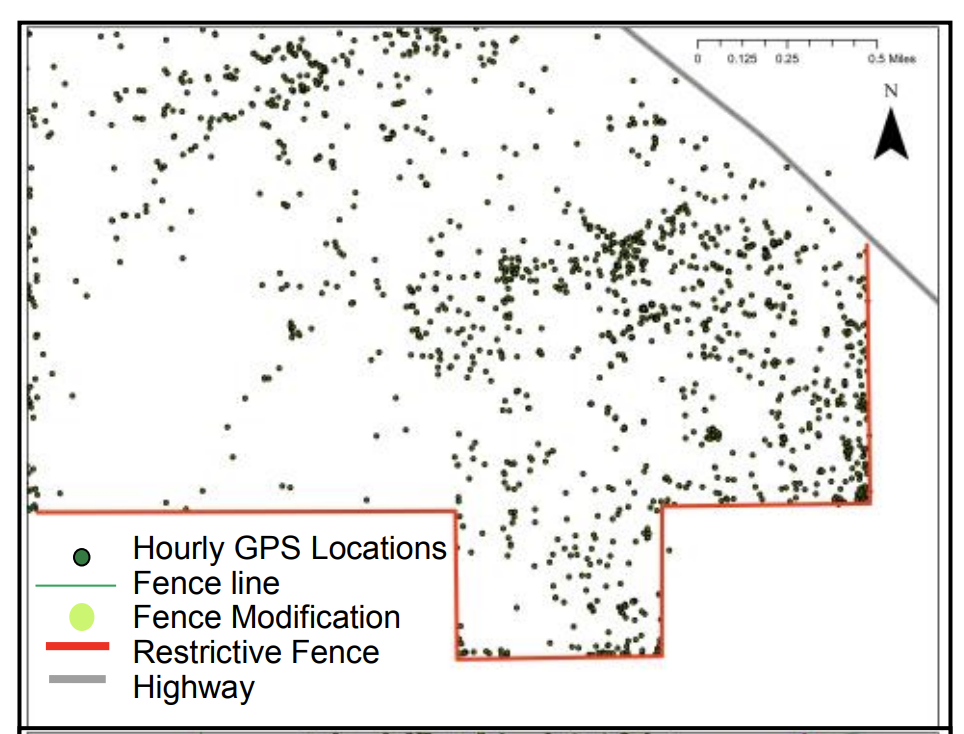
Texas Parks and Wildlife Department recommends raising the bottom wire of fences at least 18” in height (link). Pronghorn are able to duck under fencing at this height while maintaining speed. The ability to move more freely helps them avoid intelligent predators such as coyotes, allows them to locate needed forage, and also allows them to spread out and not need to congregate around resources, reducing the potential spread of parasites.
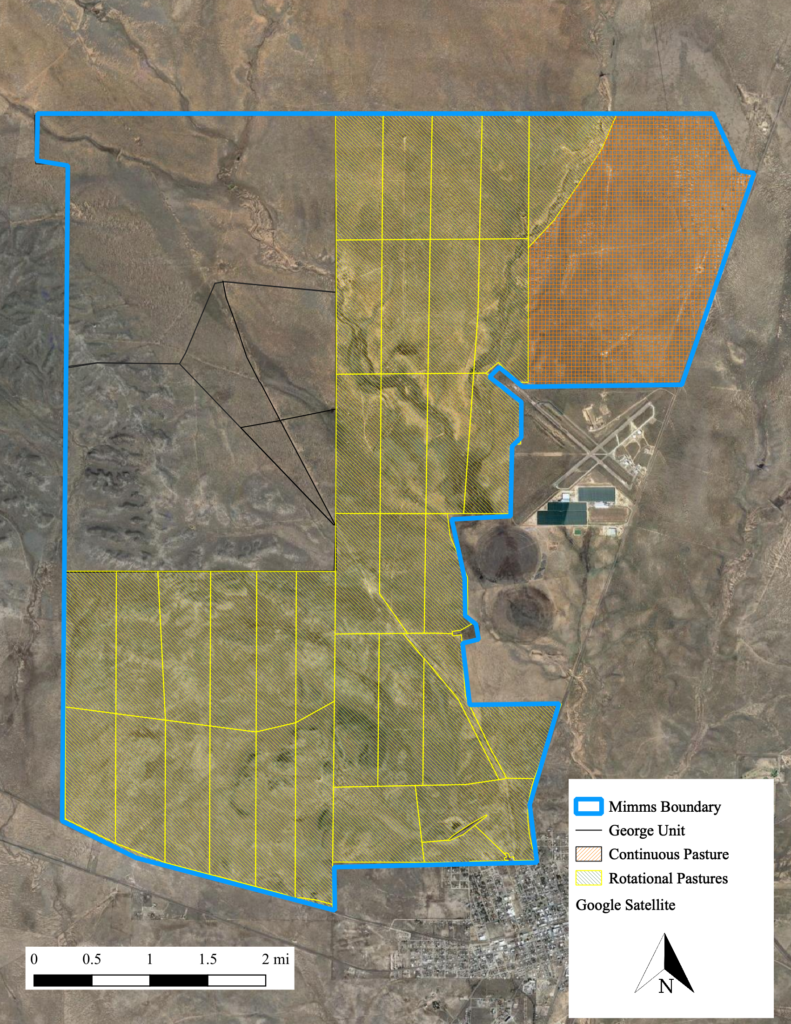
Fencing
Dixon Water Foundation utilizes a single strand of electric wire to create our pasture boundaries. The majority of the Mimms Unit is partitioned into 34 pastures that are fenced with this single-strand wire and are rotationally grazed (Figure 7). We have found that training our livestock to the single electric wire allows us to further subdivide these 34 pastures as we see fit by stretching a temporary wire from boundary to boundary. This allows us to control the grazing period and stock density in a given area, so that we can leave adequate forage on the land to catch future rainfall, and to give grazed vegetation a lengthy recovery period. As we monitor and plan our grazing schedule, we can also incorporate a plan for the pronghorn fawning season and plan to leave ample groundcover in fawning grounds.
This single-strand wire also stands at about 30” in height, providing sufficient space for pronghorn to duck underneath, maintaining speed to avoid predators, and the freedom to access habitat.


Grassland Birds
In order to achieve our mission to promote watershed health, our management goals are to maintain good groundcover of grasses and forbs. These plants will help us catch rainfall and contribute to the health of our soil and future grass growth, allowing us to support healthy watersheds and a working cattle operation. These plants and animals contribute to the organic matter stored in the soil. Increasing soil organic matter by just 1% can lead to an increase of thousands of gallons of water storing capacity per acre (link 1, link 2).
These grasslands are also home to several bird species. Many of these species breed in the northern Great Plains and winter in the Chihuahuan Desert. It has been reported that North American birds have seen declines of 3 billion birds since 1970 (Rosenberg et al. 2019). The most threatened areas are grasslands. The sustained presence of these birds on our ranch tells us that the native grasses needed by these birds are also present and that we are managing to maintain a functional native prairie. Additionally, resident birds such as scaled quail utilize these grasslands.
Since 2014, we have sponsored on-going bird surveys and studies on our Marfa grasslands ranch. A 2019 report covering surveys conducted from 2013-2018 stated that grassland bird densities on the Mimms Unit, and an adjacent property under grazing management by Dixon Water Foundation, increased over that time period. The two ranches were found to have considerably higher bird densities than previous estimates for the region for the years 2009-2011 (CEC 2013). This suggests to ecologists studying bird populations within the region that the grazing management approach is supportive of habitat needs of many grassland bird species of concern. However, many species have different habitat needs and there are still many habitat relationships and ecosystem dynamics that still need to be researched.
In a continuation of the research started in 2013, a comprehensive report detailing research from 2016-2019 was compiled by TPWD (TPWD 2019). During these studies, researchers measured the presence of seeds that are essential to grassland bird diet between the various grazing regimes on the Mimms. Analysis of soils showed that the rotationally grazed pastures had more variable seed sources and also contained the seed for genus Panicum, while the continuously grazed pastures did not. This seed is the most abundant in the diet of grassland bird species in Northern Mexico. The presence of this seed in the rotational pastures and lack thereof in the continuously grazed pastures may be related to grazing technique, soil type, rainfall, or other physical characteristics between sites. Researchers were only able to determine that both the common diet seeds and a higher variation of seeds were available in the rotationally grazed pastures as opposed to the continuously grazed pastures. Their research also suggested that two of the primary species of concern, Baird and Grasshopper Sparrows, are more likely to be found in sites as grass height increases and shrub height is lower.
A separate study looked into diversity and abundance of grassland bird species between the grazing regimes on the Mimms Unit in 2017 and 2018. This study found that the rotationally grazed pastures offered better habitat and featured more abundant and diverse grassland bird populations. Rotationally grazed pastures also offered better scaled quail habitat and had higher scaled quail populations.
TAKEAWAYS
Ground cover monitoring, conducted annually from 2010-2021 by Dixon Water Foundation staff, shows a lower average percentage of bare ground (18%) in the rotationally grazed pastures (Figure 8) versus the percentage of bare ground in the continuously grazed pasture (39%)(Figure 9). Ranch-wide averages have shown a decrease in bare ground cover across all grazing regimes for that same period (Figure 10).
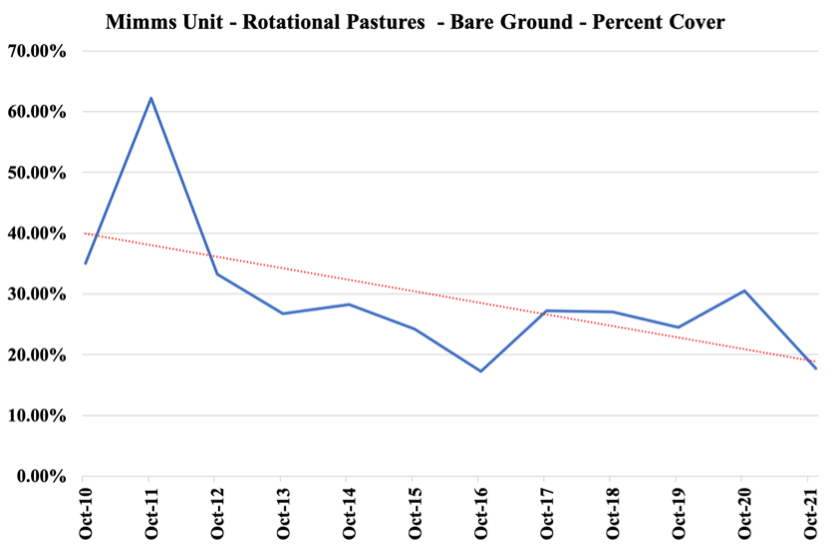
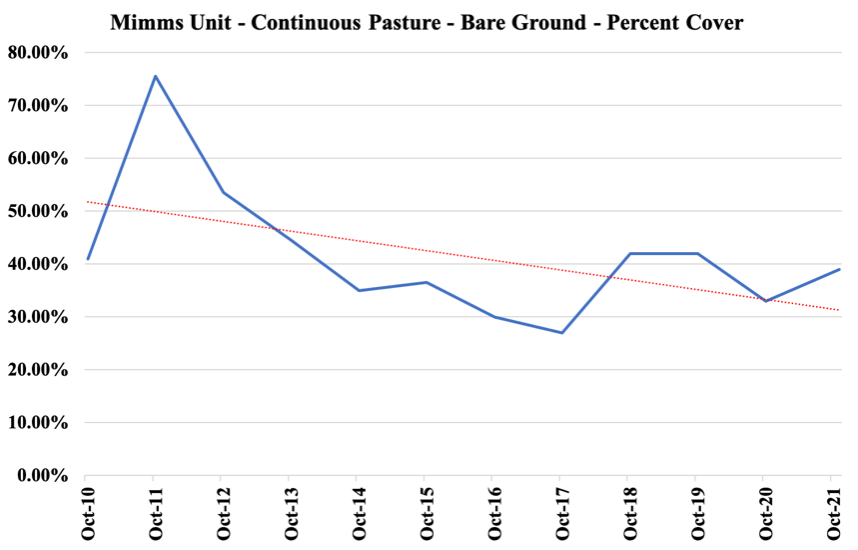
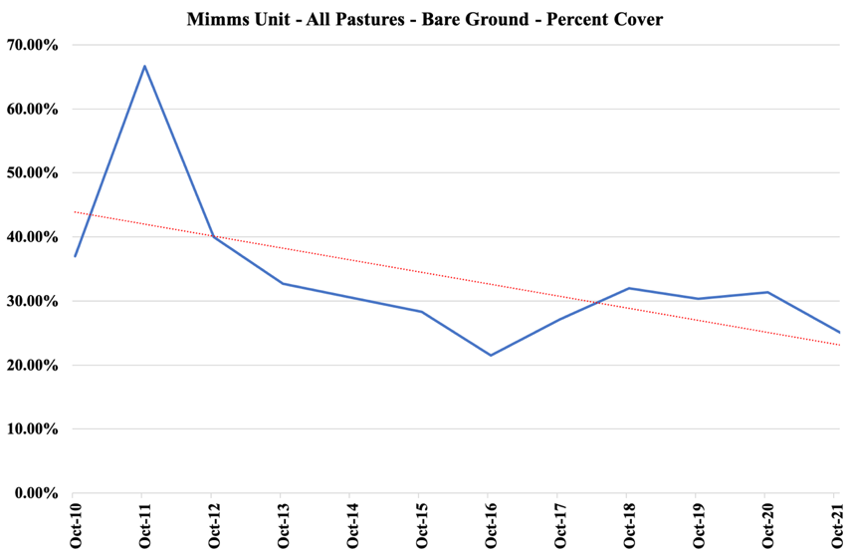
Our monitoring efforts employ a method developed by Holistic Management International. The process involves traveling to fixed monitoring points each year where staff throw 100 darts into the air around each point. As the darts hit the ground, staff document what type of ground cover the dart landed on: bare ground, litter, or basal plant cover. The staff member also documents the type of plant closest to the dart, based on 10 categories: Prairie complex, High Seral Grass, High Seral Forb, Blue & Black Grama, Mid Seral Grass, Mid Seral Forb, Introduced Grass, Sedges, Low Seral Grass, and Low Seral Forbs (Figure 11, Figure 12).
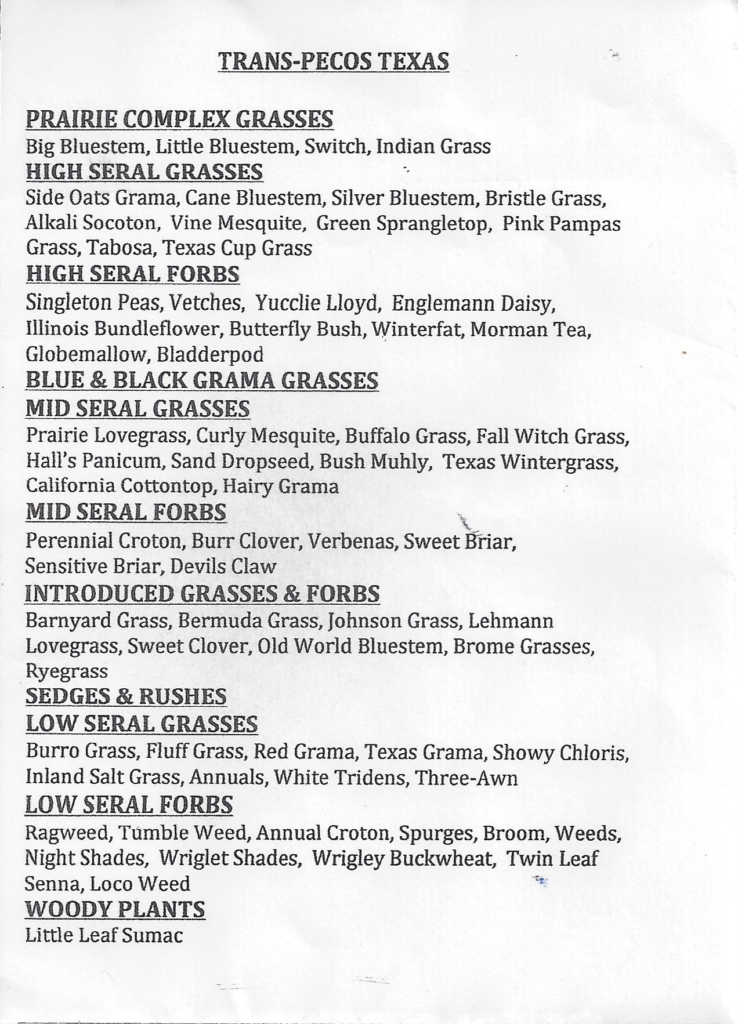
Within semi-arid environments, some bare ground is expected as resources are limited and vegetation often forms in patterns that maximize the partitioning of water. This pattern is referred to as banded vegetation and can be seen around the world. Typically, as water sheds down slope, vegetation forms in these bands along the contour of the slope, catching the moisture and utilizing it for growth. This band of vegetation tapers downslope, as water becomes more scarce, until giving way to bare ground where the water resources have been used up. Water from precipitation events then sheds off of this next patch of bare ground as the banded pattern repeats (Figure 13). This vegetation pattern, with the naturally occurring presence of bareground, is most likely important for several ground-dwelling grassland bird species that utilize vegetation and seeds for shelter and diet requirements, but need bareground patches to evade predators.

Rotational grazing also allows for a planned grazing approach, which can manage to leave adequate groundcover, including managing for grass height to promote bird habitat or fawning cover for pronghorn. This type of grazing allows for more strategy than a set-stock approach, where the cattle will graze when and where they want within a pasture. Planned grazing also promotes a wider variety of plants, as cattle most likely eliminate certain preferred plants from the continuously grazed system by repeatedly selecting for them. Anecdotally, we often observe high quality grass species throughout the rotationally grazed portion of the ranch while only finding these plants in protected locations within the continuously grazed portion of the ranch, such as within a cactus or shrub.
In ranching, every operation is different and every ranch is unique. Through running our own operations and by offering our ranch as a research and demonstration site, we are happy to participate in these studies to be able to gain a better understanding of how wildlife communities utilize the various sites we manage. It is also part of our mission to share this information with others who are working in land management and may find it potentially useful for their own practices. For more information, please contact us through our website dixonwater.org .

LITERATURE CITED
- Carr, Bill. 2019. Plant Species Observed on Mimms Ranch, Presidio County, Texas. Privately contracted plant inventory.
- Gann, Whitney et al. 2017. Trans-Pecos Pronghorn Restoration and Research Report. Borderlands Research Institute, Sul Ross State University, Alpine, Texas.
- French, Justin. 2015. Pronghorn diet, nutrition, and habitat assessment in Trans-Pecos, Texas. Thesis. Sul Ross State University, Alpine, Texas.
- Taylor, Charles A. et al. 1980. Diet Selection by Cattle under HighIntensity Low-Frequency, Short Duration, and Merrill Grazing Systems. Journal of Range Management 33(6), p. 428-434.
- Locke, Jacob et al. 2021. The Effects of Continuous and Rotational Livestock Grazing on Forb Quality and Quantity: Implications for Pronghorn Habitat Management. Range Ecology and Management. 77, p. 75-81.
- Weaver, James. 2015. The role of parasites, diseases, mineral levels, and low fawn survival in a declining pronghorn population in the Trans-Pecos region of Texas. Thesis. Sul Ross State University, Alpine, Texas.
- Nichols, Ron. 2017. A Hedge against Drought: Why Healthy Soil is ‘Water in the Bank’. Online article US Department of Agriculture.
- Ahmed, Abdallah. 2021. Conservation Agriculture Effects on Soil Water Holding Capacity and Water-Saving Varied with Management Practices and Agroecological Conditions: A Review. Agronomy. 11, 1681.
- Rosenberg, Kevin et al. 2019. Decline of North American Avifauna. Science. 366, 6461.
- CEC. 2013. Where do grassland birds winter? Density, abundance and distribution of wintering grassland passerines in the Chihuahuan Desert. Commission for Environmental Cooperation.
- TPWD 2019. Final Performance Report. Habitat relationships of grassland birds in the Chihuahuan Desert. Texas Parks and Wildlife Department.
- Williams, Kaitlyn. Effects of Livestock Grazing on Scaled Quail and Grassland Birds in the Marfa Grasslands, Texas. Thesis. Sul Ross State University, Alpine, Texas.
